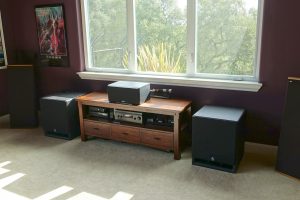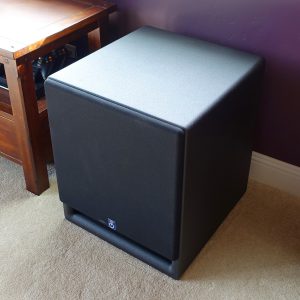It’s rare that I go out to movie theaters, preferring to have friends over to enjoy my home theater, but sometimes I do for special movie events, like the release of the first new Star Wars movie in a long time: The Force Awakens. Well, we happened to go to a theater with an impressive sound system and I was startled by a number of instances in the movie where you could seriously feel the sound pressure of something big happening on screen or the impact of an explosion, not just *hear* it. In other words, some serious pressure waves in that theater. That experience left me wanting to find out how to get that at home!
I’ve long been pretty content with my Acoustic Research S12HO subwoofer (a 12″ inch down-firing driver), particularly in my old condo’s home theater. It filled out the bass response well, without being overbearing and without bothering the neighbors. I’ve had it since 1999. However, in my home now in the hills above Santa Cruz, I have a much larger room with a huge vaulted ceiling and my old subwoofer can’t really fill the room. (Plus I don’t have close neighbors to worry about bothering.)
So I did my usual many days of research and ended up settling on getting two (yes, two!) highly-rated V1800 subwoofers from Power Sound Audio. The V1800 subwoofer features a 725 watt amplifier and a huge, vented 18″ driver capable of getting down below 16 Hz. It’s capable of delivering up over 120 dB of sound. (Here’s a list of comparative decibel levels.) I bought two of them because a single subwoofer can potentially fill a room in such a way that you get large peaks of output in some locations in the room and large dips, even dead spots, in other locations. Adding a second subwoofer in a different location allows it to interact with the room in such a way that its peaks and valleys will tend to cancel out the other subwoofer so you get a more even response throughout the room. It also has the side effect of increasing the output overall by quite a bit (about 6 db).
Here’s a great set of tips on how to go about optimizing both subwoofer placement and crossover settings. For me, the only really practical location was up front on either side of my equipment cabinet:
Even with the large vaulted space of my home theater, I found that the appropriate gain setting needed for both subwoofers was only about 20%. It was amusing to turn them both up to 50% gain though just to see what would happen. The room shakes so hard at that level that I’m afraid of turning it up any further for fear of breaking something like a window.
Anyway, set an appropriately balanced level, their impact (literally and figuratively) is still quite dramatic. These guys fill out the bass end of music wonderfully, nice and tight, without being overbearing at all. And for low frequency effects (LFE) in movies, the experience is fantastic. The rumble from a passing train in a movie makes you believe there really is a train passing by. A rocket launch shakes the whole room (and much of the house) – you feel it in the floor, the walls, the chairs. And most amazing of all, you feel sharp explosive impacts on your chest. No need to strap subwoofers to your chairs! “Tron Legacy” makes for a great bass demonstration throughout. I particularly love how you literally feel a jolt to your chest when Sam is struck by the laser digitizer and transported into the digital world.

